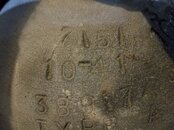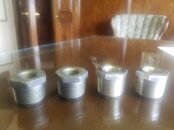@Johnoly
I suspect the method used by me and many others in the genesis is a brighter red. So much of our equipment was adapted from existing items , home made (see "the Mask" ) or improvised
Originally all the valves were all 1/2 pipe thread , the O ring seal did not appear until Sportsways (Later Waterlung) introduced them to diving in the early 1960s.
The 1/2 valve required and very substantial vise to secure the tank in order remove the value
The components were a length of old well used fire hose an automobile and a Crescent wrench
The procedure was a follows
roll out the fire hose flat
lay the tank on the fire hose
fold the bitter end back over the tank
drive the automobile over the fire hose forming a wedged vise
Remove valve with Crescent wrench
If required get out he metal stamp kit and hydro the tank
It should be noted the valves were seldom removed until John Gaffney and NASDS created the VIP Program in 1967- which was accidentally created when a SCUBA tank exploded and blew Bob Whitehead through a shop wall and broke his leg.
The valves were removed for the following reason;
When the valve were damaged
When the tank "swished" when shook = water in tank
When the tank rattled = rust in tank
When the tank was turned upside down the valve opened on a piece of paper and it became saturated with oil= bad fill from faulty compressor
And that wuzz the way it wuzzzz in the beginning of recreational diving,
Sam
Cc
@Scuba Lawyer -- bring back memories of days gone by ?





